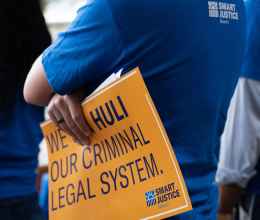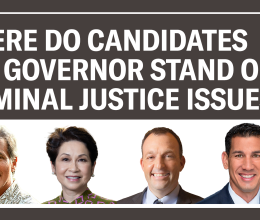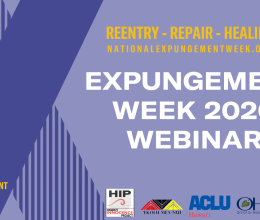
You should visit jails and prisons too. I make frequent trips to see my brother in prison, and I also visit other jails and prisons throughout the country. It is an eye-opener. There is a pipeline, my friends, one that runs from classroom to jail, from the playground to the prison. When you visit the incarcerated you’ll see how utterly decent most of these men and women are, how they got a bad deal because they were poor with no one to advocate for them.
Michael Eric Dyson, “Tears We Cannot Stop: A Sermon to White America”
Despite the perception that Hawai‘i is a blue oasis of transformation and progressivism, much of the State has a conservative bent when it comes to ‘crime and punishment.’ This means, among other things, that our law enforcement community has a history of resisting reform, our state administration tends to favor “tough on crime” rather than “smart on crime” policies, and by and large the public has let it happen. This has been a problem for decades, which is why we still turn to incarceration as the easy answer far too often in Hawai‘i. As of December 7, 2020, there were 4,175 people incarcerated under the jurisdiction of the Hawai‘i Department of Public Safety. This is lower than the 5,524 people incarcerated as of this time last year, which is due in no small part to the work Ekolu Mea Nui, Lawyers for Equal Justice, the ACLU of Hawai‘i, and other local activists did in advocating for the release of people from cages during COVID. But these numbers may rise again post-pandemic, and we know that at any given time about half of those people are incarcerated pretrial.
The Office of Hawaiian Affairs (OHA) has reported that people who are Native Hawaiian, Compact of Free Association (COFA) migrants, and Filipinos are charged and convicted more often and get harsher sentences than other groups. To divert the continued overcrowding, for over a decade the State has paid a private, for-profit prison company, Core Civic (formerly the “Corrections Corporation of America” (CCA)), to house over 2,000 of our residents in Eloy, Arizona at Saguaro Correctional Center. As of November 2020, 1,126 of Saguaro’s 1,926 beds were occupied by prisoners from Hawai‘i. And as of December 13, 2020, 672 Hawai‘i prisoners housed at Arizona’s private Saguaro Correctional Center have tested positive for COVID-19, and one man living at the prison recently died. One of our long-term goals is to bring these men back home to Hawai‘i from Saguaro.
This is all to say that work remains to be done. We are three years into the Smart Justice campaign, and we envision two to three more. Current problems include: too many people sit in jail and prison for things that don’t make sense; race and wealth play a significant role in how you are treated in the criminal legal system; the legislature is not brave or visionary enough; there is a lack of transparency in prosecutors’ offices; too many local prosecutors still go for wins instead of fairness or justice; Native Hawaiians and Pacific Islanders are disproportionately impacted at every stage of the process; there is not enough funding for diversion programs; even when reform laws are passed, they’re not adequately carried out; people returning to the community confront unbearable barriers; people are still consistently and repeatedly punished for past mistakes.
To counter this, our vision for the future includes: correctional facilities that actually rehabilitate people; using the criminal legal system as the last resort and reserving it for the most serious of crimes; reserving detention and deprivation of liberty for situations that pose the highest risk to public safety; an evidence-based correctional system; profit playing no role in the criminal legal system; the state not incarcerating anyone out-of-state in a private prison; the community not viewing people who are incarcerated as ‘different’; accountability not automatically being equated with incarceration; prosecutors not measuring wins by convictions; people being set up for success when leaving incarceration; funding community programs instead of incarceration; Native Hawaiians and Pacific Islanders not being targeted and incarcerated; no new jails being built just to house more people; the public demanding change; and candidates for public office actually campaigning proactively in favor of the use of clemency, prosecutorial reform, and probation and parole reform.
We aim to see a significant reduction in the number of people deprived of their liberty as well as significant reductions in the racial and economic disparities in the criminal legal system. Some of this will require legislative fixes, but some of this work can be done unilaterally through greater use of the Governor’s clemency powers. As described by Jason Hernandez, “[c]lemency has historically been relied upon in America as an olive branch extended to those unduly harmed by our system of mass punishment. It has been used as a tool to heal people, communities, and our very nation, and in doing so, has engendered reconciliation among its citizens. Clemency is a corrective measure that counteracts some of the effects of a flawed system. But the degree to which it can do so is mirrored by the degree to which it is used.” And contrary to what many people believe, greater use of a Governor’s clemency powers is popular. A poll released by the ACLU in August 2020 found widespread support for governors to use their clemency authority to correct past injustices. Eighty percent of all voters support ending or shortening the prison sentences of certain people in prison. This includes 86 percent of Democrats, 73 percent of Republicans, and 81 percent of independents. Among those who have personally been a victim of a crime, 82 percent support clemency.
Some of this work can be done administratively through greater support for reentry systems and by forcing the Department of Public Safety to simply comply with its existing statutory obligations around reentry. As we noted in our May 12, 2020 ACLU of Hawai‘i letter to the Special Master (concerning releases from jail during the pandemic), reentry planning is critical to ensuring people successfully reenter the community. Successful reentry methods give people exiting jails and prisons chances to support not only themselves but their families, which reduces recidivism and improves public safety. Studies have shown that reentry methods centered around securing post-incarceration employment, treatment, education, and housing all help people make a successful transition. Even things as straightforward as providing cell phones, clothing, identification cards, and transitional housing can be transformational. Things like this are all too often not being provided by our state government, though, so private groups have had to step in. But this is too important for government to sit on the sidelines, and there are some things only government can provide. As 95% of all incarcerated people eventually return to the community, using evidence-based rehabilitation strategies through reentry planning must be a priority.

